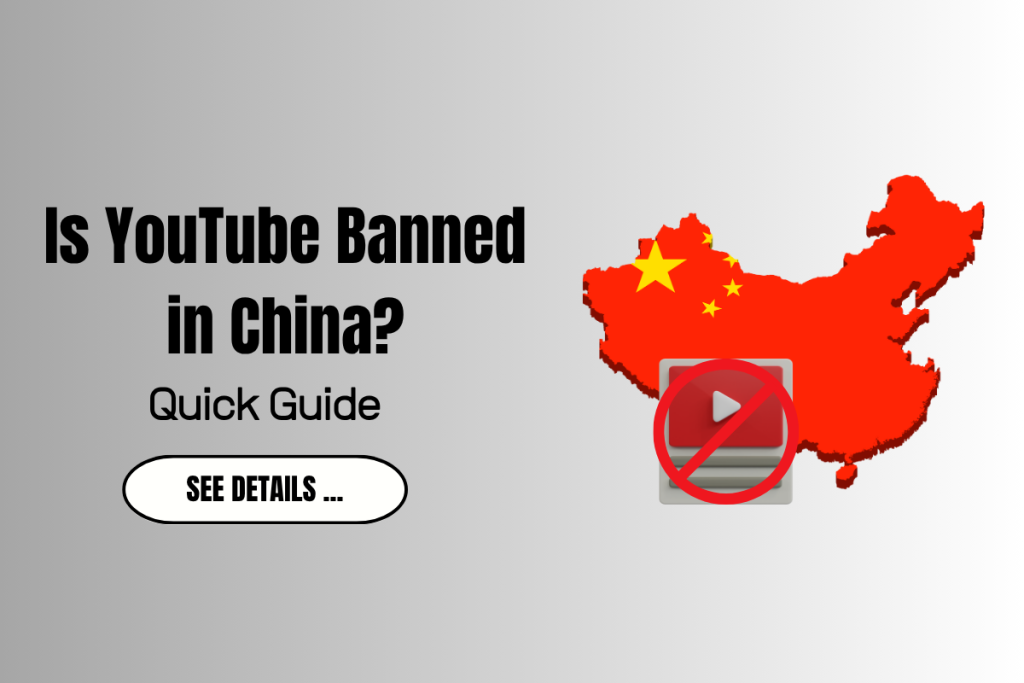Is YouTube banned in China? Yes, absolutely. Since 2009, the Chinese government has completely blocked YouTube along with other major platforms like Google and Facebook. No standard internet connection in mainland China—whether hotel WiFi or regular mobile data—can access YouTube. Fortunately, travelers have two reliable workarounds: VPNs that encrypt and reroute your connection, or specialized China eSIMs with built-in unrestricted access. This guide compares both methods to help you choose the best option for your trip.

I. Is YouTube Banned in China?
Yes, YouTube is completely blocked in mainland China. The ban has been in place since March 2009 following political unrest in Tibet when videos of protests appeared on the platform. This restriction is part of China’s comprehensive internet censorship system known as the “Great Firewall.”
While inaccessible throughout mainland China, YouTube remains freely available in Hong Kong, Macau, and Taiwan, which operate under different regulatory systems.
Chinese internet users have adapted by using local alternatives:
- Youku – The closest equivalent to YouTube
- Tencent Video – Popular for entertainment and dramas
- Bilibili – Favored by younger audiences for anime and gaming content
Travelers to China should prepare by installing a reliable VPN before arrival to access YouTube and other blocked international services.
II. Why is YouTube Blocked in China?
YouTube has been inaccessible in mainland China since 2009 due to several key government priorities:
- Censorship enforcement: YouTube’s open platform makes it difficult for authorities to control political content that might criticize the government or discuss sensitive topics like Tiananmen Square or Tibet.
- Media control: China strictly regulates information flow to its citizens, and YouTube’s user-generated content model contradicts this control system.
- Protecting domestic platforms: Blocking YouTube creates market space for Chinese alternatives like Youku, Bilibili, and Tencent Video to develop and dominate.
- Data sovereignty: China requires user data to remain within its borders under government oversight, while YouTube stores data on international servers.
These restrictions are enforced through China’s sophisticated “Great Firewall” filtering system, which blocks numerous international platforms deemed incompatible with China’s internet governance model.
III. What Happens If You Try to Access YouTube in China?
Attempting to use YouTube in mainland China produces these immediate results:
Complete website failure: YouTube.com won’t load at all – your browser will show a loading icon indefinitely before timing out with a generic connection error.
Missing embedded videos: YouTube videos embedded on other websites appear as empty gray boxes or error messages.
No error explanation: You won’t see any message stating the site is blocked – just standard connection errors like “This site can’t be reached” or “Connection timed out.”
Broken website functionality: International news sites and blogs using YouTube embeds will have noticeable gaps or malfunctioning elements.
IV. How to Watch YouTube in China (2 Reliable Methods)
YouTube is blocked in China due to the country’s internet restrictions, but with proper preparation, you can still access the platform during your visit.
Method 1: Use a VPN
A Virtual Private Network (VPN) creates an encrypted connection that bypasses China’s internet restrictions. This approach works for accessing most blocked content but requires technical setup.
Using a VPN in China involves:
- Installing the application before arriving in China (critical as VPN websites are blocked)
- Connecting to servers outside mainland China, typically in Hong Kong or Singapore
- Managing occasional connection disruptions during government crackdowns
While effective, VPNs can be complicated to set up and may experience unstable connections.
Method 2: Use an eSIM with VPN Compatibility (for Travelers)
For most travelers, a specialized China eSIM offers the most convenient solution. These digital SIM cards provide built-in access to global websites without additional configuration.
Chinaesim.com offers several advantages that make it ideal for tourists: No VPN required for most plans – access YouTube, Google, and other services directly Affordable pricing starting from just $7 for 5-day plans with sufficient data Instant delivery – receive your eSIM via email immediately after purchase Simple activation – just scan a QR code before your trip
Customer reviews confirm the reliability of this approach. As one user noted: “I used both meta- and google-based apps while travelling in Jiangsu region with no problems.”
The eSIM solution is particularly valuable for short-term visitors who want hassle-free access without technical complexity. Just ensure your device is compatible with eSIM technology (most modern smartphones from iPhone XS/Samsung S20 and newer support it).
For the smoothest experience in China, purchasing an eSIM before your trip provides the most reliable way to stay connected to YouTube and other blocked services.
V. FAQs
Is YouTube blocked in Hong Kong?
No. YouTube is freely accessible in Hong Kong as the region operates under different internet regulations than mainland China. Hong Kong maintains its own internet infrastructure without the content restrictions found in mainland China.
Can I access YouTube with mobile data in China?
No with standard SIMs, but possible with specialized eSIMs. Regular Chinese mobile data plans block YouTube and other international sites, but services like chinaesim.com offer “No VPN required” data plans that allow direct access to YouTube.
Does YouTube work in hotels or airports in China?
No. Neither hotel WiFi nor airport networks in mainland China allow YouTube access. These networks operate under the same national internet restrictions as all other connections in mainland China and are often subject to even stricter monitoring.